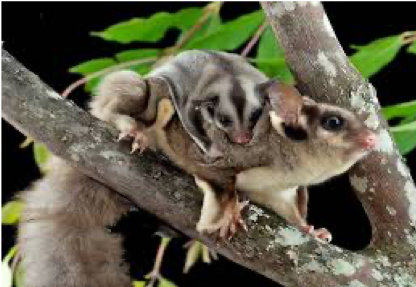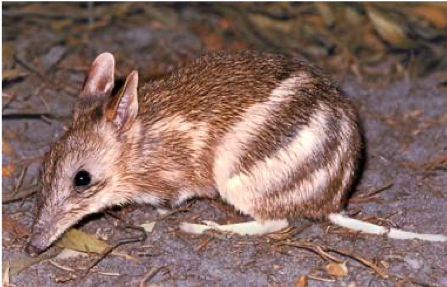AoS 1: Gliders and Bandicoots
Background
Sugar Glider (Petaurus breviceps)
Like many Australian species, Sugar gliders are in decline. They require mature trees with well-developed hollows. Habitat destruction and fragmentation are of particular concern, reducing the number of available hollows. However, in Tasmania, where Sugar Gliders were introduced, they have become a pest, threatening populations of the endangered Swift Parrot.
Eastern Barred Bandicoot (Perameles gunii)
The Eastern Barred Bandicoot is a small, rabbit sized marsupial with a long pointy nose and ears. According to the Environment Protection and Biodiversity Conservation Act (EPBC Act), it is classified as endangered across Australia but as of March 2013, it has been classified as extinct in the wild on the Advisory List of Threatened Vertebrate Fauna in Victoria.


Mt Rothwell
Mt Rothwell is a wildlife sanctuary situated on approximately 420 hectares behind the You Yangs. This sanctuary comprises native grasslands and grassy woodlands which provides habitat for many native animals, which are threatened, critically endangered or extinct on mainland Australia, such as Bettongs, Bandicoots, Potoroos, Wallabies, Gliders and Quolls. The animals are protected from introduced species and the habitat is continually managed to provide optimal conditions.
Prior Knowledge
Some prior explanation of the importance of biodiversity would be a benefit. However, this program can be taught with no prior knowledge.
Learning Intentions
In this program students will:
- Explain the importance of biodiversity
- Learn how to use a model to make predictions on past or future population trends in an ecosystem
- Explain the advantages and disadvantages of several sampling techniques
- Learn how to complete a habitat assessment
- Suggest reasons to explain the conservation status of the Eastern Barred Bandicoot
- Explain the differences in the outcomes for these two small Australian marsupials
Activities
Students will:
- Classify Grassy Woodland ecosystem renewable services using the 4 categories: Provisioning, regulating, supporting and cultural services using the unique ‘Volcano Dreaming’ panels
- Get up close and personal to Ecolinc’s resident Sugar Gliders.
- Use a compound microscope to identify mammals that have been sampled using hair traps
- Investigate changes in a woodland ecosystem using the Newbyte woodland foodweb program and use this computer model to investigate how bandicoots went extinct in the wild.
- Complete a scavenger hunt at Mt Rothwell looking for evidence of animals
- Complete a habitat assessment at Mt Rothwell
- Go on a guided spotlight tour to observe Eastern Barred Bandicoots and other native endangered species at Mt Rothwell
Notes:
This program commences at 1.30pm. Students will undertake a series of activities at Ecolinc and will then travel by bus to Mt Rothwell and undertake further grassland activities. Students can bring their own dinner or BYO food for a bbq. Students will then be taken on a spotlighting tour of Mt Rothwell at dusk by Mt Rothwell staff. Here they will get the chance to observe many of our native endangered grassland species that have been released on this 420 predator free property.
There is an additional fee per student for the Mt Rothwell program. Teachers need to also be aware that if the temperature is above 35 degrees and/or the weather conditions are extreme, Mt Rothwell will not accept students on site. In this situation, students undertaking this program will participate in an alternative/like program on site at Ecolinc.
Students will need to wear appropriate attire (warm clothing and wet weather gear) and good walking shoes.
This program is available in Term 2 only once daylight savings has finished.
VCE links
Importance of biodiversity
- The definition and categories of biodiversity: genetic, species and ecosystem.
- The importance of genetic diversity within a species or population experiencing environmental change.
-
Ecosystems as a source of renewable services that impact on human health and well-being:
- provisioning services: potable water; food; fuel; fibre; and pharmaceuticals
- regulating services: control of climate and disease; pollination; and water purification
- supporting services that maintain conditions for life on Earth: cycling of nutrients; soil formation; and photosynthesis
- cultural services: aesthetic values; recreational benefits; and sense of place.
Assessing changes in species diversity
- Practical techniques used for assessing species diversity: sampling with grids, transects and different shaped quadrats, including consideration of edge effects and mark-recapture.
- Conservation categories for ranking species according to their risk of extinction: extinct in the wild; critically endangered; endangered; vulnerable; near threatened; and least concern.
- Qualitative assessment of conservation status to identify the species most in need of conservation action: changes in availability of suitable habitat, geographic distribution, and population size.
Threats to biodiversity
- Human and non-human threats to biodiversity: creation and isolation of small populations through habitat loss and over-exploitation; inbreeding due to small population size; loss of pollinators, dispersal agents, host species or symbionts that affect reproduction and persistence of species; bioaccumulation that concentrates some persistent pollutants within organisms and biomagnification along a food chain; climate change; disease; and introduced species that compete for shelter, food and water
Protection and restoration of biodiversity
- Strategies for maintaining and growing populations that also build species resilience to changes in the environment: protected areas; retaining remnant vegetation; wildlife corridors or zones; translocation of animals; captive breeding and reintroduction programs; gene banks for the collection of specimens and genetic material; and reduction and improved targeting of pesticides in agricultural and urbanised areas .
- Approaches to renewing and regenerating degraded ecosystems: restoration of habitat; erosion control; and reintroduction of previously endemic species.
- The application of relevant international, national, state and local legal treaties, agreements and regulatory frameworks that apply to the protection of threatened species: the Convention on International Trade in Endangered Species of Wild Fauna and Flora (CITES); IUCN Red List of Threatened Species; classified World Heritage areas; Environment Protection and Biodiversity Conservation Act 1999 (Cth); Flora and Fauna Guarantee Act 1988 (Vic); and local government conservation covenants.
- Value systems that influence decision-making processes: anthropocentrism, biocentrism, ecocentrism and technocentrism.
- Sustainability principles as they apply to biodiversity conservation: conservation of biodiversity and ecological integrity; efficiency of resource use; intergenerational equity; intragenerational equity; precautionary principle; and user pays principle.

